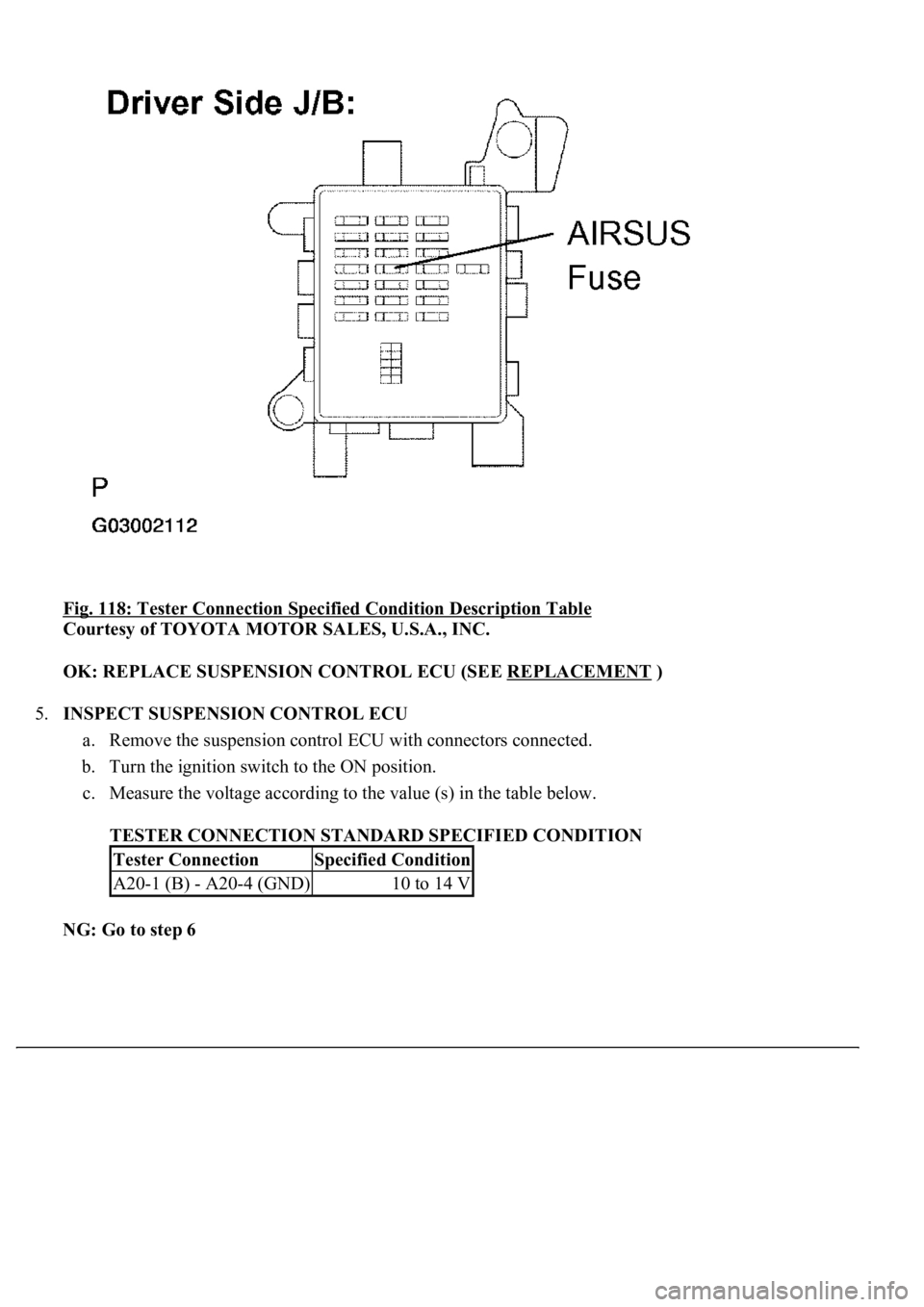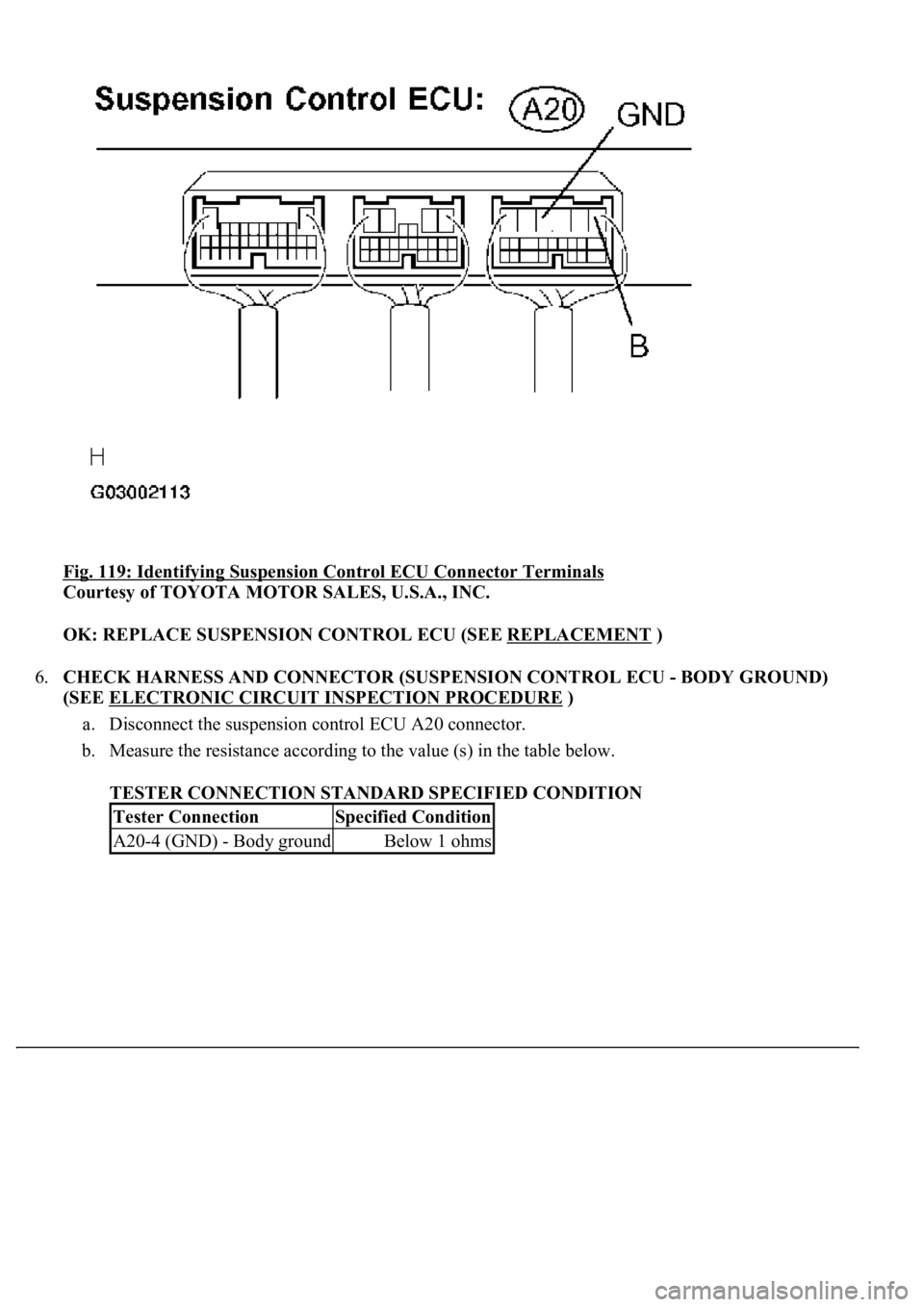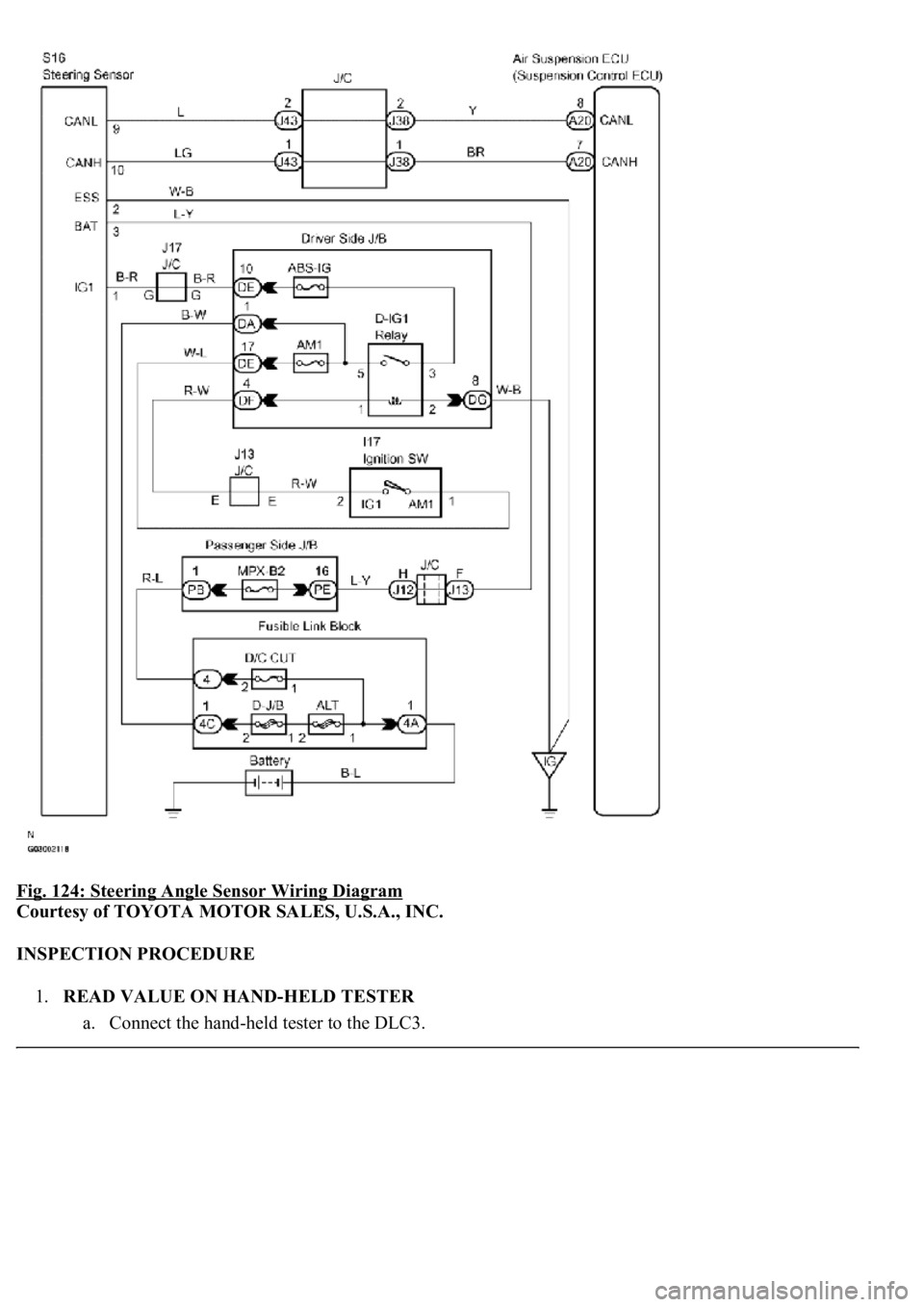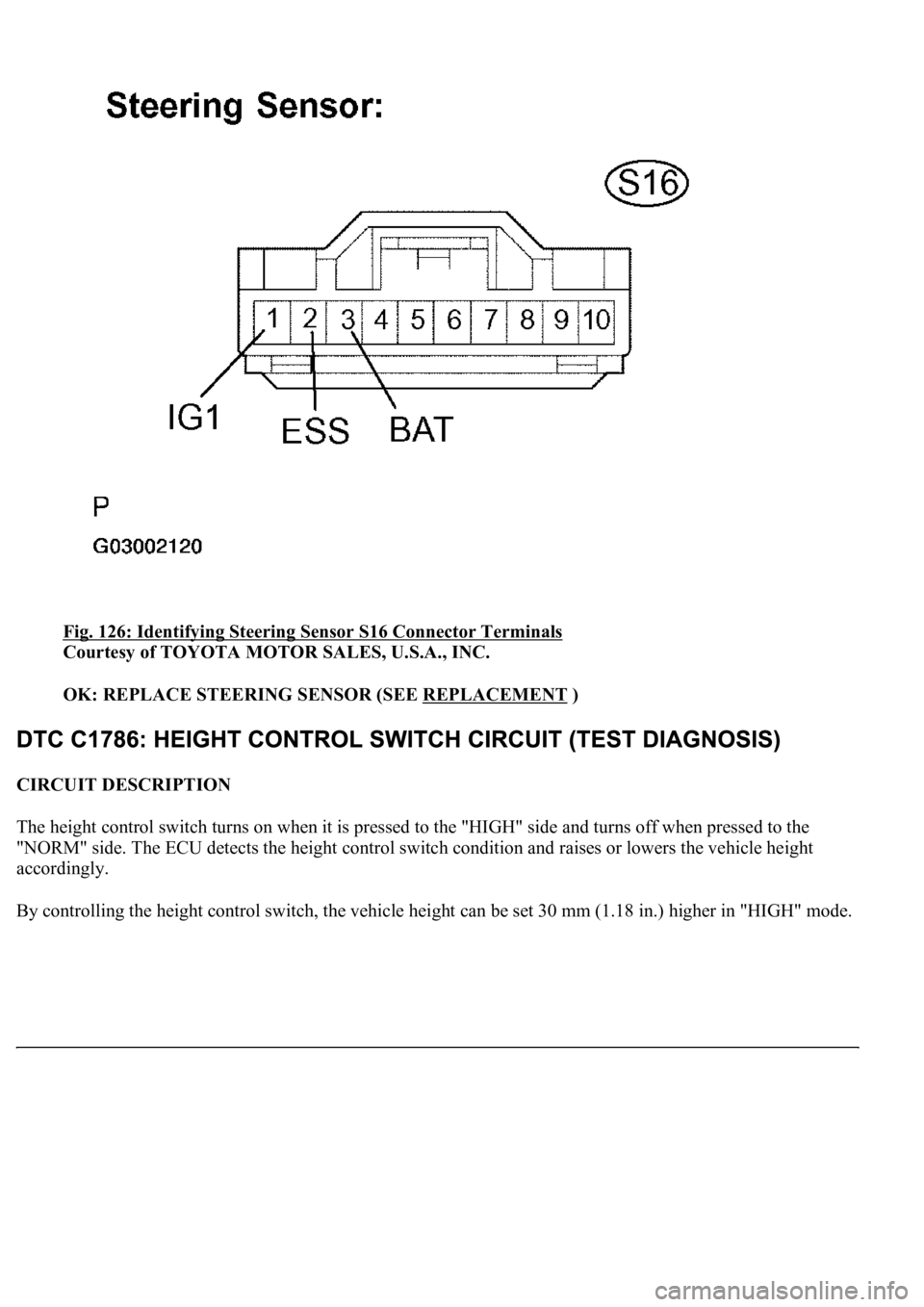LEXUS LS430 2003 Factory Repair Manual
Manufacturer: LEXUS, Model Year: 2003,
Model line: LS430,
Model: LEXUS LS430 2003
Pages: 4500, PDF Size: 87.45 MB
LEXUS LS430 2003 Factory Repair Manual
LS430 2003
LEXUS
LEXUS
https://www.carmanualsonline.info/img/36/57050/w960_57050-0.png
LEXUS LS430 2003 Factory Repair Manual
Trending: oil change, tires, ABS, Expansion Valve, change key battery, hood release, Door lock actuator
Page 601 of 4500
Fig. 116: Identifying AM1 Fuse Location
Courtesy of TOYOTA MOTOR SALES, U.S.A., INC.
NG: CHECK FOR SHORT IN ALL HARNESS AND CONNECTOR CONNECTED TO FUSE
AND REPLACE FUSE
OK:Go to next step
4.INSPECT FUSE (AIR SUS)
a. Remove the AIRSUS fuse from the driver side J/B.
b. Check fuse.
1. Check continuity of the AIRSUS fuse.
Standard:
Continuity
Page 602 of 4500
Fig. 117: Identifying Air sus Fuse Location
Courtesy of TOYOTA MOTOR SALES, U.S.A., INC.
NG: CHECK FOR SHORT IN ALL HARNESS AND CONNECTOR CONNECTED TO FUSE
AND REPLACE FUSE
Page 603 of 4500
Fig. 118: Tester Connection Specified Condition Description Table
Courtesy of TOYOTA MOTOR SALES, U.S.A., INC.
OK: REPLACE SUSPENSION CONTROL ECU (SEE REPLACEMENT
)
5.INSPECT SUSPENSION CONTROL ECU
a. Remove the suspension control ECU with connectors connected.
b. Turn the ignition switch to the ON position.
c. Measure the voltage according to the value (s) in the table below.
TESTER CONNECTION STANDARD SPECIFIED CONDITION
NG: Go to step 6
Tester ConnectionSpecified Condition
A20-1 (B) - A20-4 (GND)10 to 14 V
Page 604 of 4500
Fig. 119: Identifying Suspension Control ECU Connector Terminals
Courtesy of TOYOTA MOTOR SALES, U.S.A., INC.
OK: REPLACE SUSPENSION CONTROL ECU (SEE REPLACEMENT
)
6.CHECK HARNESS AND CONNECTOR (SUSPENSION CONTROL ECU - BODY GROUND)
(SEE ELECTRONIC CIRCUIT INSPECTION PROCEDURE
)
a. Disconnect the suspension control ECU A20 connector.
b. Measure the resistance according to the value (s) in the table below.
TESTER CONNECTION STANDARD SPECIFIED CONDITION
Tester ConnectionSpecified Condition
A20-4 (GND) - Body groundBelow 1 ohms
Page 605 of 4500
Fig. 120: Identifying Suspension Control ECU Connector Terminals
Courtesy of TOYOTA MOTOR SALES, U.S.A., INC.
NG: REPAIR OR REPLACE HARNESS OR CONNECTOR
OK: REPLACE SUSPENSION CONTROL ECU (SEE REPLACEMENT
)
CIRCUIT DESCRIPTION
The speed sensors monitors the speed of the wheels, and sends an appropriate speed signals to the suspension
control ECU through the brake actuator assy (skid control ECU).
If trouble occurs in either the right rear speed sensor or left rear speed sensor, DTC (C1776) is output.
Page 606 of 4500
Fig. 121: DTC C1776 Detecting Condition And Trouble Area
Courtesy of TOYOTA MOTOR SALES, U.S.A., INC.
WIRING DIAGRAM
Fig. 122: Speed Sensor Wiring Diagram
Courtesy of TOYOTA MOTOR SALES, U.S.A., INC.
INSPECTION PROCEDURE
1.READ VALUE ON HAND-HELD TESTER
a. Connect the hand-held tester to the DLC3.
b. Turn the ignition switch to the ON position and turn the hand-held tester main switch on.
c. Select the item below in the DATA LIST and read its value displayed on the hand-held tester.
NORMAL CONDITION AIRSUS
d. Check that there is no difference between the speed value output from the speed sensor displayed
on the hand-held tester and the speed value displayed on the speedometer when driving the vehicle.
OK:
There is almost no difference in the displayed speed values.
ItemNormal Condition
WHEEL SPD FRActual vehicle speed
Page 607 of 4500
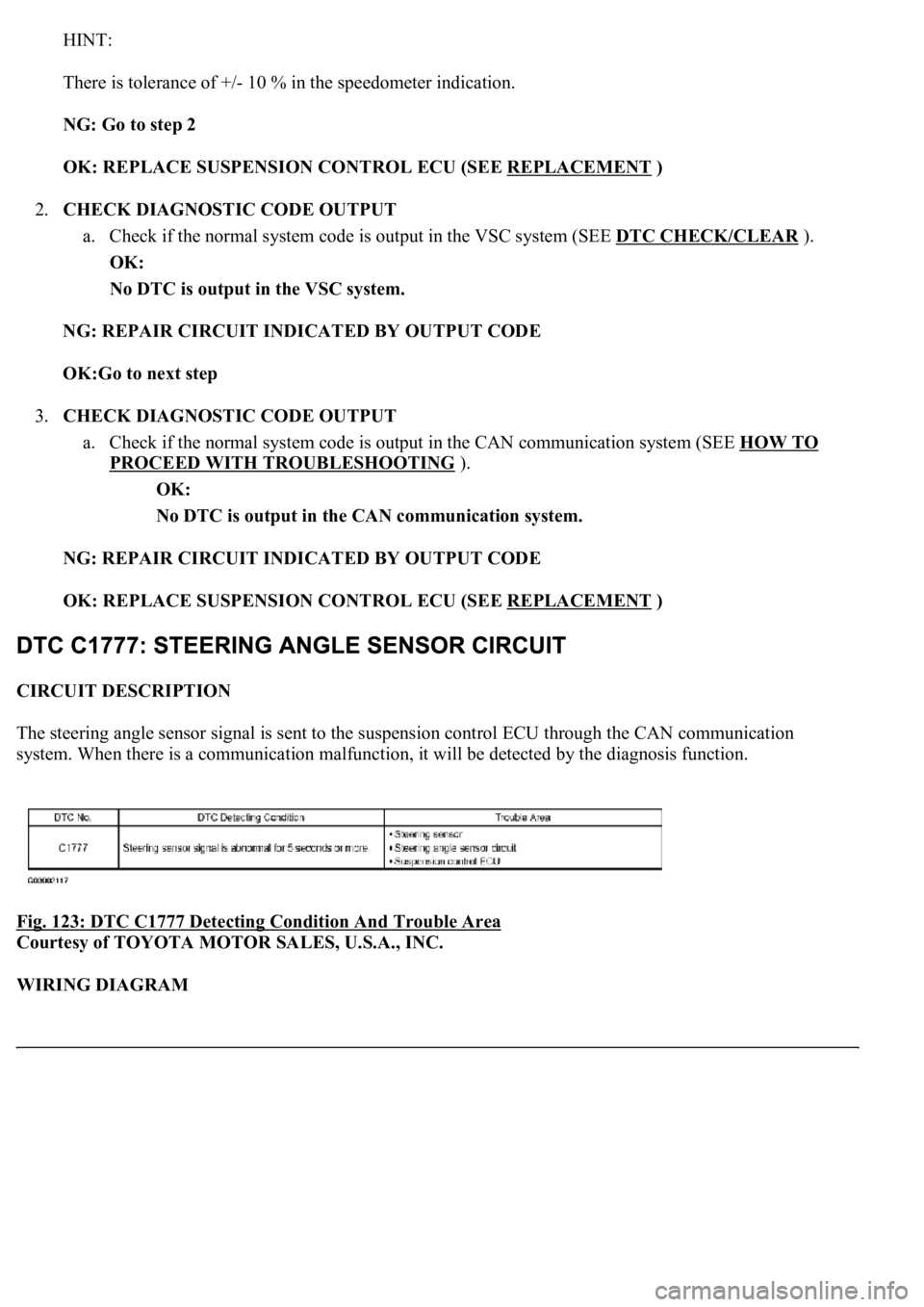
HINT:
There is tolerance of +/- 10 % in the speedometer indication.
NG: Go to step 2
OK: REPLACE SUSPENSION CONTROL ECU (SEE REPLACEMENT
)
2.CHECK DIAGNOSTIC CODE OUTPUT
a. Check if the normal system code is output in the VSC system (SEE DTC CHECK/CLEAR
).
OK:
No DTC is output in the VSC system.
NG: REPAIR CIRCUIT INDICATED BY OUTPUT CODE
OK:Go to next step
3.CHECK DIAGNOSTIC CODE OUTPUT
a. Check if the normal system code is output in the CAN communication system (SEE HOW TO
PROCEED WITH TROUBLESHOOTING ).
OK:
No DTC is output in the CAN communication system.
NG: REPAIR CIRCUIT INDICATED BY OUTPUT CODE
OK: REPLACE SUSPENSION CONTROL ECU (SEE REPLACEMENT
)
CIRCUIT DESCRIPTION
The steering angle sensor signal is sent to the suspension control ECU through the CAN communication
system. When there is a communication malfunction, it will be detected by the diagnosis function.
Fig. 123: DTC C1777 Detecting Condition And Trouble Area
Courtesy of TOYOTA MOTOR SALES, U.S.A., INC.
WIRING DIAGRAM
Page 608 of 4500
Fig. 124: Steering Angle Sensor Wiring Diagram
Courtesy of TOYOTA MOTOR SALES, U.S.A., INC.
INSPECTION PROCEDURE
1.READ VALUE ON HAND-HELD TESTER
a. Connect the han
d-held tester to the DLC3.
Page 609 of 4500
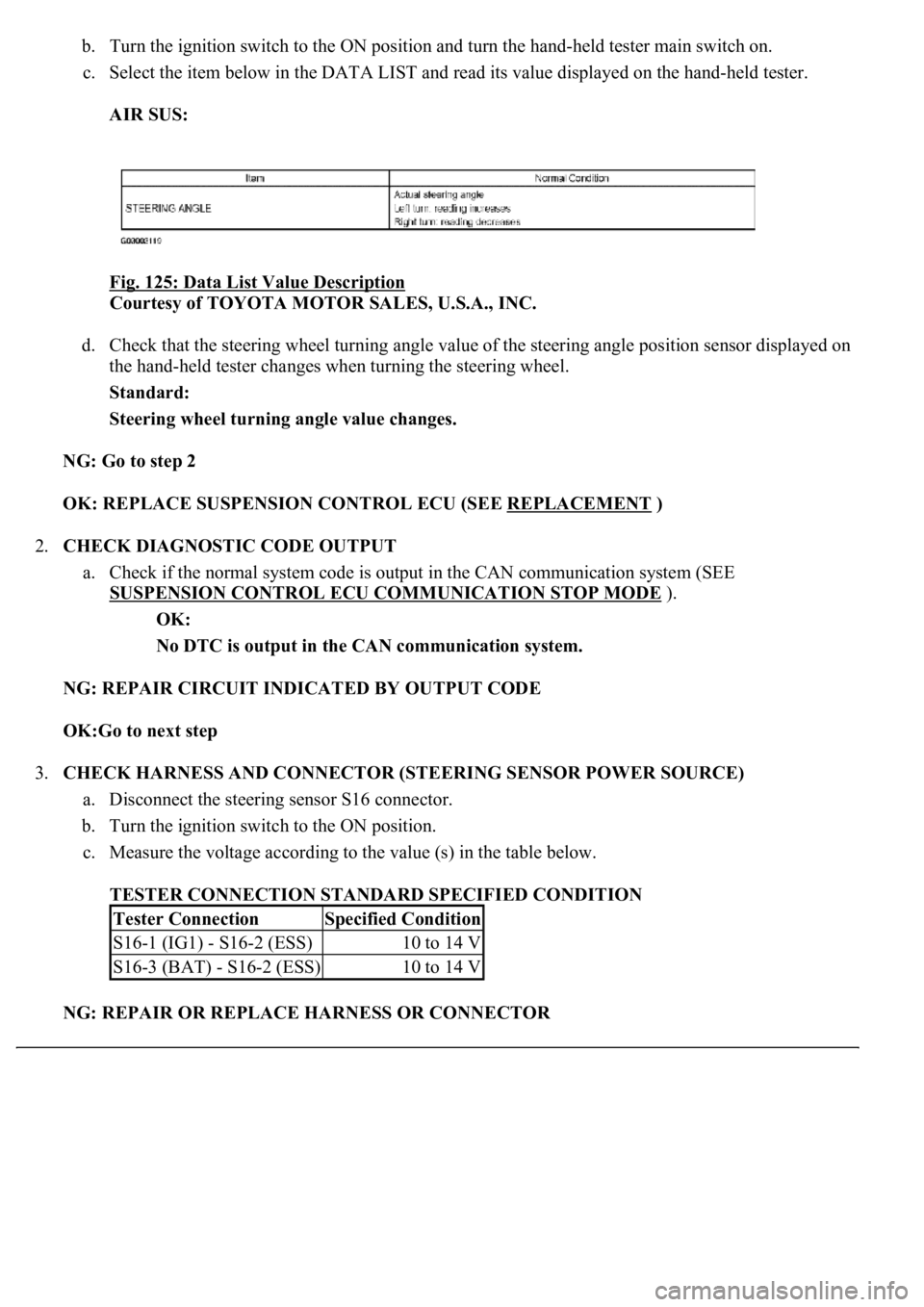
b. Turn the ignition switch to the ON position and turn the hand-held tester main switch on.
c. Select the item below in the DATA LIST and read its value displayed on the hand-held tester.
AIR SUS:
Fig. 125: Data List Value Description
Courtesy of TOYOTA MOTOR SALES, U.S.A., INC.
d. Check that the steering wheel turning angle value of the steering angle position sensor displayed on
the hand-held tester changes when turning the steering wheel.
Standard:
Steering wheel turning angle value changes.
NG: Go to step 2
OK: REPLACE SUSPENSION CONTROL ECU (SEE REPLACEMENT
)
2.CHECK DIAGNOSTIC CODE OUTPUT
a. Check if the normal system code is output in the CAN communication system (SEE
SUSPENSION CONTROL ECU COMMUNICATION STOP MODE
).
OK:
No DTC is output in the CAN communication system.
NG: REPAIR CIRCUIT INDICATED BY OUTPUT CODE
OK:Go to next step
3.CHECK HARNESS AND CONNECTOR (STEERING SENSOR POWER SOURCE)
a. Disconnect the steering sensor S16 connector.
b. Turn the ignition switch to the ON position.
c. Measure the voltage according to the value (s) in the table below.
TESTER CONNECTION STANDARD SPECIFIED CONDITION
NG: REPAIR OR REPLACE HARNESS OR CONNECTOR
Tester ConnectionSpecified Condition
S16-1 (IG1) - S16-2 (ESS)10 to 14 V
S16-3 (BAT) - S16-2 (ESS)10 to 14 V
Page 610 of 4500
Fig. 126: Identifying Steering Sensor S16 Connector Terminals
Courtesy of TOYOTA MOTOR SALES, U.S.A., INC.
OK: REPLACE STEERING SENSOR (SEE REPLACEMENT
)
CIRCUIT DESCRIPTION
The height control switch turns on when it is pressed to the "HIGH" side and turns off when pressed to the
"NORM" side. The ECU detects the height control switch condition and raises or lowers the vehicle height
accordingly.
B
y controlling the height control switch, the vehicle height can be set 30 mm (1.18 in.) higher in "HIGH" mode.
Trending: inter lock cable, trunk, fuel filter location, headrest, Speedometer, Absorber suspension, ECO mode


